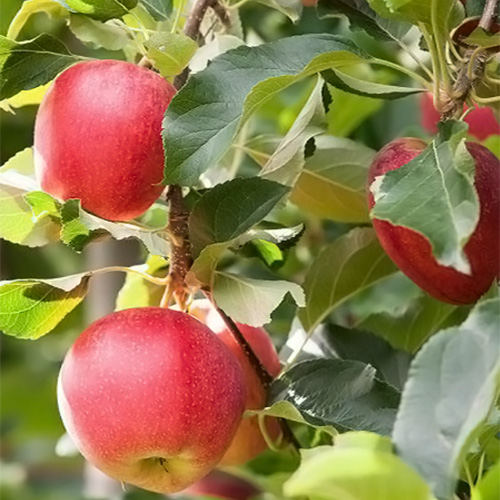
Summer Red Apple Tree
Origin: USA
Description:The Summer Red Apple Tree is an early season variety known for its vibrant red apples and compact growth habit. It is especially suited for cooler climates and has a moderately fast growth rate. This variety is appreciated for its ornamental value as well as its fruit production, with dense foliage and an attractive blossom display in spring.
Fruit: The fruit of the Summer Red apple tree is medium-sized with a smooth, bright red skin that is highly attractive. The flesh is white and crisp, offering a refreshing tartness that is ideal for fresh eating. The apples also hold up well in cooking and baking, retaining their shape and flavor.
Harvest: The harvest period for Summer Red apples is early in the season, typically in late August, which allows them to capture a market niche for early apples. The fruit tends to mature uniformly, facilitating efficient harvesting.
Pollination: Summer Red apples require cross-pollination for optimal fruit set. Compatible pollinators include McIntosh, Jonathan, and Empire apples.
Spacing: Recommended spacing for Summer Red apple trees is 3 to 4 meters for semi-dwarf varieties and 2 to 3 meters for dwarf varieties. This spacing allows for sufficient sunlight and air penetration, promoting healthy growth and fruiting. Semi-dwarf trees can reach heights of up to 3.5 meters, while dwarf trees typically grow up to 2.5 meters.
Good to know: This variety is noted for its adaptability to various soil types and resistance to common apple diseases such as mildew and scab, reducing the need for chemical interventions. The Summer Red apple also has a relatively low chilling requirement, making it suitable for a wider range of climatic conditions. Additionally, its early harvest time and attractive appearance make it a popular choice for both commercial orchards and home gardeners.
ask prices
- We only sell bare root trees to countries in Europe. We can't export potted trees due to trade regulations.
- We can deliver the trees to all countries in Europe and some countries in Eurasia and Middle East. We can arrange a truck to deliver the trees to your country.
- We are a wholesale nursery. Our minimum order quantity is 3.000 trees. Please note that we don't take orders below this limit.
- Phytosanitary certificates are provided with all orders. These certificates prove the origin of the trees and certify that they are free of diseases.
MM 9 (Dwarf)
M 9 is a dwarf rootstock suitable for high-density planting. It is resistant to the crown rot disease and moderately sensitive to the fire blight and wooly aphid. It is resistant to the illness of the tree tree and mildly susceptible to the blight of flames and wooly aphid. Throughout cultivation, it requires support systems. It should not be grafted on spur-type varieties such as Scarlett Spur, Redchief and Starkspur Golden. For the field, it should be recommended without limiting watering. It is moderately resistant to calcareous and heavy-textured soils. High crop quality, early fruit bearing and elevated efficiency out of a unit region within a brief span of moment are the most advantageous features M 9 offers to the plants.
MM 106 (Middle size)
It is a semi-dwarf rootstock, resistant to wooly aphid and is highly sensitive to disease of crown rot. For heavy-textured and argillaceous soils, it should certainly not be suggested. It has a closer and heavier root structure than rootstocks M9 and M26. Although it is more resistant to the climate than rootstocks M9 and MM 26, it should be chosen for frequent watering plants.For the gardens where MM 106 is grown, support devices are not needed. Within three or four years after planting, it becomes commercially profitable.
MM 111 (Large)
It is a semi-dwarf rootstock bigger than M106 and smaller than standard seedling rootstock. It is resistant to the illness of crown rot, wooly aphid and heavy-textured, argillaceous, calcareous plants with a pH scale above 7. Depending on the circumstances of care, it becomes commercially profitable within four or five years. When early flowering is desired, M 9 may be recommended as the rootstock between the system in some cases. When grafted on spur form and low strength varieties, it provides stronger outcomes.






